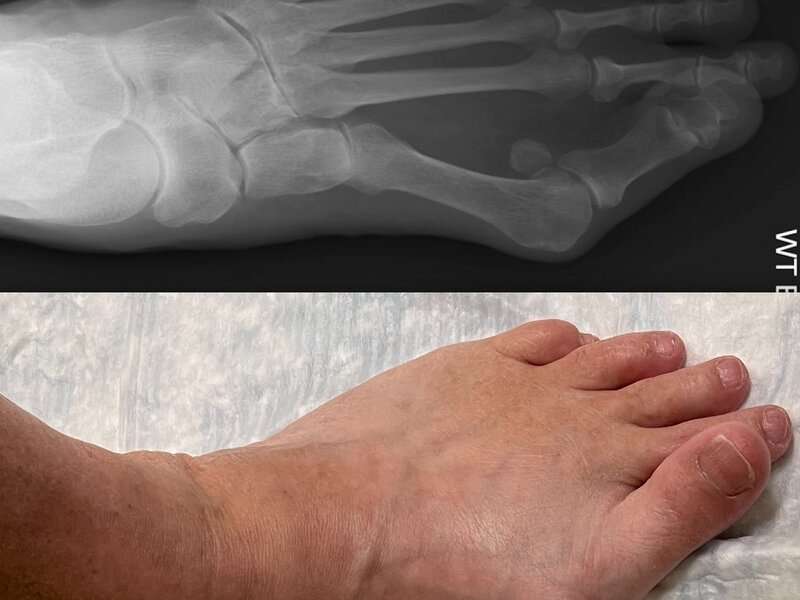This article has been reviewed according to Science X's editorial process and policies. Editors have highlighted the following attributes while ensuring the content's credibility:
fact-checked
reputable news agency
proofread
Got bunions? Key factors to whether surgery will work for you

When it comes to bunions, millions of Americans are painfully familiar with the signs: Swelling, redness, a telltale bulge on the side of the big toe. Corns and calluses where other toes rub together. And pain. Lots and lots of pain.
Fortunately, when surgery is needed, it's usually a success. But not always.
So researchers have stepped up with a new study highlighting the key factors that may determine the procedure, known as modified Lapidus surgery, will be unsuccessful.
"We set out to find if certain characteristics—patient or procedure-based—were associated with failure of the bunion surgery," said study author Dr. Matthew Johnson, an assistant professor of orthopaedic surgery at the University of Texas Southwestern Medical Center in Dallas.
Bunions form on the base of the big toe when the long metatarsal bone shifts toward the inside of the foot and its phalanx bones angle toward the second toe. As the soft tissue of the foot rubs up against shoes, pain results.
"Patients [are] unable to perform their normal daily activities such as walking, other exercises, or even standing in some severe cases," Johnson said.
As many as one-third of American adults have bunions, which typically owes to wearing poorly fitting shoes and/or genetics.
Patients can apply padding or try wider-toe shoes and/or arch supports to take the pressure off. But those aids don't always do the trick.
When all else fails, Lapidus surgery aims to straighten, realign and fuse the bones of the big toe and the arch, with the goal of improving patients' daily functioning and mobility, Johnson said.
"Most research has shown only a small percentage of bunion surgery patients did not find the surgery beneficial," he said.
About 10% of the time the procedure fails to achieve a healthy and permanent union of the bones, leaving the patient with continued pain and disability after surgery.
In search of an explanation, Johnson and his colleagues studied the medical records of 222 bunion surgery patients.
The vast majority were women (87%), at an average age of 51. Their average body mass index (BMI)—a measure of body fat based on height and weight—was just over 28, meaning they were overweight.
Nearly 1 in 10 had unsuccessful bunion surgery. Three patient characteristics seemed to drive up the risk that bones won't heal together as intended, Johnson said.
The first factor was weight: The higher a patient's BMI, the greater their risk of surgical failure.
Failure risk was also higher among patients whose bunions had a "bigger preoperative angle," meaning a relatively more severe form of bunions.
The likelihood of failure was also higher for patients who had prior bunion surgery.
However, a history of smoking was not linked to increased risk, a finding that surprised Johnson.
His hope now is that surgeons will take note of those factors that do appear to undercut surgical success, in order to set more realistic expectations with bunion patients considering surgery.
Dr. Raymond Monto, an orthopedic surgeon with Nantucket Cottage Hospital in Massachusetts, found "no real shockers" in the new analysis of a procedure that's been around for nearly a century.
"The real message of this study is something that most surgeons already know, but that most of the public has been shielded from," said Monto, who reviewed the findings. "Bunion surgery has one of the highest complication rates of any surgery."
His advice: "If a patient does have a painful bunion that cannot be managed by more accommodating footwear and is considering surgery, they would be well advised to have a candid discussion with their surgeon about the potential for surgical complications, and prepare for any procedure by first losing weight and stopping smoking."
Caution should guide any decision to undertake the operation, Monto said.
"As one of the great foot surgeons of the 20th century, Dr. Leonard Goldner, once said to a bunion patient: 'It would probably be better to operate on your shoe rather than on your foot,'" Monto said.
The findings were published in the Journal of Foot and Ankle Surgery.
More information: There's more about bunions at the Cleveland Clinic.
Benjamin Wang et al, Identifying Risk Factors for Nonunion of the Modified Lapidus Procedure for the Correction of Hallux Valgus, The Journal of Foot and Ankle Surgery (2022). DOI: 10.1053/j.jfas.2022.01.001
Copyright © 2023 HealthDay. All rights reserved.


















